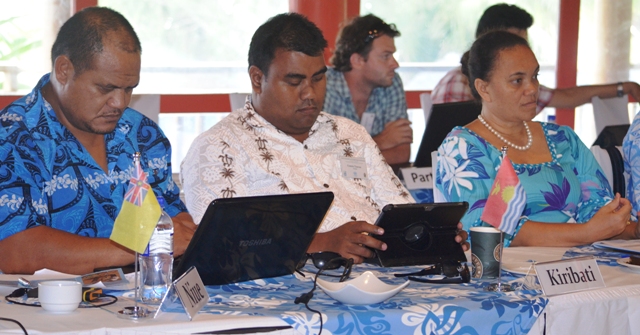
Climate Change Resilience
Meteorological Acronym for today: SCOPIC - Seasonal Climate Outlook Software provided by the Climate and Oceans Support Program for the Pacific
3 April 2014, Rarotonga Cook Islands - Endorsed and adopted in 2011, the Tarawa Drought Response Plan was developed to help address dry spells.
Along with assessing information from water reservoir tanks and groundwater conditions on the island, the plan also relies on climate forecasts from the Kiribati Meteorological Service (KMS) to activate three levels of the response - awareness of the community on current and projected rainfall and appropriate measures to conserve water; advising the community of potential risk to National Water Reserves and increased awareness about wise water use; and the third level, which is an official declaration of a drought.
Developed by the Water Engineering Unit of the Ministry of Public Works and Utilities with support from the Secretariat of the Pacific Community (SPC), the plan brings together a range of different sectors to deliberate on climate information from the Kiribati Meteorological Service.


"It's not easy, it requires a lot of work – both from the water and the meteorological sector; we not only need to take into account the rainfall status and outlook but also conditions of the groundwater in the reservoirs and wells," said Ueneta Toorua of the Kiribati Meteorological Service.
"Information from KMS is provided on a monthly basis. When the criteria is met for a certain level, the plan is activated and the team starts meeting. It’s a bit challenging for KMS to be able to meet the commitment of providing the information due to our limited staff numbers, there are only three of us, and the number of products and services."
Since the adoption of the Drought Response Plan there has not been a major prolonged drought period in Kiribati but there have been instances when criteria has been met for Level 1 and 2. In August 2012 warnings were issued but there was no declaration of a drought.


One of the tools used by the Kiribati Meteorological Service is what is known as SCOPIC, Seasonal Climate Outlook Software provided by the Climate and Oceans Support Program for the Pacific (COSPPac). It is a statistical model that allows the Kiribati Met Service to carry out rainfall prediction and data analysis taking into account the monthly rainfall data and sea surface temperature injected in the software. A pilot project with COSPPac is now revising the methodology used in this response plan.
"We're concerned about what happens after projects comes to an end and need to think of regional approaches to sustain tools like SCOPIC software and the CliDE database, which are really helpful to us. We'd like to be able to continue using them even after the COSPPac or PACCSAP has ended."
Pacific meteorological directors, stakeholders and development partners have come together from 31 March to 4 April in the Cook Islands for the Regional Consultation on Climate Services for Pacific Small Island States and Related Meetings.